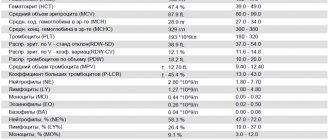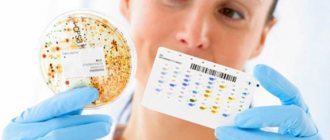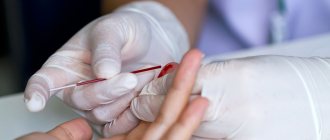To make an appointment with a doctor
Calling a pediatrician to your home
Our doctors
Our prices
November 11, 2021
Author of the article: Morozova Ekaterina Vyacheslavovna
Pediatrician, Candidate of Medical Sciences, member of the Union of Pediatricians of Russia
Experience: 15 years
+ Make an appointment
Every disease has its own root cause. Moreover, it can be either congenital or acquired. One of the most important controllable variables in the life of the body is the level of glucose in the blood or glycemia. This is the most important source of energy, which ensures the normal functioning of all organs and tissues. Deviation from the norm can become a provoking factor in the development of various diseases. Therefore, it is extremely important to control blood sugar in children and adults.
What values are considered normal?
There is a certain norm for blood sugar in children. But this indicator is determined by the age of the child.
Glucose levels depend on many factors, including:
- nutrition;
- work of the digestive tract;
- the influence of various hormones (thyroid, adrenal glands, glucagon, insulin, etc.).
To understand whether children's blood sugar levels are normal, you should compare test results with the required indicators. Below is a table with the normal blood sugar levels in children depending on age (indicators are measured in mmol/l.).
| up to 12 months of age | from 2.8 to 4.4 |
| 1 year | from 3.3 to 5.0 |
| 2 years | from 3.3 to 5.0 |
| 3 years | from 3.3 to 5.0 |
| 4 years | from 3.3 to 5.0 |
| 5 years | from 3.3 to 5.0 |
| 6 years | from 3.3 to 5.5 |
| 7 years | from 3.3 to 5.5 |
| 8 years | from 3.3 to 5.5 |
| 9 years | from 3.3 to 5.5 |
| 10 years | from 3.3 to 5.5 |
| over 11 years old | from 3.3 to 5.5 |
Based on this table, the normal blood sugar level in children is determined.
What method is blood taken for sugar?
As a rule, such an analysis is carried out in laboratory premises. Blood for analysis from a baby is usually taken from a finger. Blood collection, as in adults, requires certain preparation before analysis. Glucose concentration reaches its maximum level within 2 hours after eating. For this reason, the analysis is carried out on an empty stomach. The last meal should be consumed at least 9-12 hours before donating blood, otherwise the result will be inaccurate. Therefore, after calculating the time before the analysis, feed your child heavily at dinner, since in the morning you will have to do without breakfast. Water consumption should be kept to a minimum. And dentists also advise not to brush your teeth before the test, so that sugar from toothpaste does not enter the child’s body through the gums. If the indicators are too high, a repeat analysis is prescribed to ensure the accuracy of the result. Sometimes a blood test is prescribed to check the level of glycated hemoglobin.
Causes of sugar level deviations
The reasons influence whether a child’s blood sugar will be high or low. Moreover, they can be very different. But to understand all this, you should study in more detail what high and low blood sugar in a child is.
Low blood sugar in a child
If children's blood sugar levels drop below normal levels, then hypoglycemia is diagnosed. This is dangerous because with such a diagnosis, frequent feelings of hunger, trembling, sweating, weakness, confusion, and slow speech may occur. Convulsions often occur. Indicated for insufficient blood sugar in children and loss of consciousness.
The cause of low blood sugar in a child may be:
- insufficient water consumption;
- prolonged fasting;
- insulinoma;
- severe chronic diseases;
- CNS diseases;
- diseases associated with the digestive tract (including gastritis, pancreatitis, etc.);
- sarcoidosis;
- arsenic or chloroform poisoning.
All this affects the reduction of blood sugar levels in children.
High blood sugar in a child
If, when compared with the table of blood sugar norms in children, it is found that the test results are higher than the established values, this means that the glucose level is elevated. This leads, first of all, to the conclusion that the child may develop or already has diabetes mellitus.
High blood sugar in a child may be due to:
- the presence of diseases of the thyroid gland, pituitary gland or adrenal glands;
- pancreatic tumors;
- overweight (obesity);
- long-term use of anti-inflammatory non-steroidal drugs, as well as glucocorticoids.
An incorrect test can show elevated blood sugar levels in children. These are the cases when blood is donated when the child is excited, tense or has had a heavy meal.
When should you see a doctor?
Blood sugar in children should be regularly monitored, because minor deviations from the norm do not always appear externally. Identifying many diseases in the early stages allows you to prevent consequences and prevent the disease from developing. Therefore, once a year or more often, parents should take their child for a blood draw. This is how you can control blood sugar levels in children.
You should definitely contact a specialist if you notice that the child is often weak, he begins to speak more slowly, and is confused in his thoughts. You should immediately visit a doctor if your baby has seizures or loses consciousness. A pediatrician can determine the normal blood sugar level in children. And if deviations occur, then the specialist issues a referral to an endocrinologist. You can contact JSC "Medicine" (clinic of Academician Roitberg), located in the central district of Moscow. Specialists will promptly carry out diagnostic measures and prescribe the necessary treatment.
Diagnostics
To determine the normal blood sugar level in children, you need to take a routine finger prick test. If the results are elevated, then the child will be given a repeat blood draw, which will help accurately determine the glucose level.
Consequences
If, according to the table, the blood sugar level in children is low, this can lead to the development of hypoglycemic coma, which is deadly. Elevated glucose levels are the first sign of the presence or gradual development of diabetes mellitus.
Could the results be unreliable?
The risk that test results are unreliable always exists. This can be influenced by the child’s physical condition at the time of blood collection (activity, agitation, etc.), as well as the fact that the baby ate before donating blood. To exclude any errors, the doctor always prescribes a repeat test.
Blood test for glucose in children: what does deviation from the norm show and what does it mean?
Sugar is a popular and beloved product by many. But not everyone knows about another type of sugar - glucose, which is found in our body. Why do we need glucose, how much of it should be contained in our blood, what are the dangers of deviations from the norm, and when can we suspect disorders in a child? Let's figure it out together.
Glucose is a carbohydrate that plays a very important role in the body, namely, it is the main source of energy. Without glucose, the vital activity of all cells in our body is impossible. We need this substance as much as fuel for cars. The amount of glucose in the blood allows you to assess the health status of a person at any age. It is very important to maintain a balance in the level of this substance. Sugar, which is familiar to us, enters the body from food, with the help of a special hormone, insulin, is broken down and enters the blood. The more sugar we eat, the more insulin the pancreas produces. However, the amount of insulin produced is limited. Therefore, excess sugar is “stored” in the liver, muscles and adipose tissue.
The balance is disturbed when we do not eat or our diet, as they say, is unbalanced. Then glucose levels drop, which leads to deterioration in brain function. An imbalance is also possible with dysfunction of the pancreas, which produces insulin. It is worth noting that almost 10 thousand children with diabetes are officially registered in Ukraine. But not all children and their parents know about this serious diagnosis. Every year the number of young patients with diabetes is rapidly increasing.
What symptoms in a child may indicate an imbalance in blood glucose levels?
- increased thirst, dry mouth,
- frequent urination,
- weakness, sweating,
- dizziness,
- cardiopalmus
- smell of acetone from the mouth.
If your child has the above symptoms, rush him to the doctor and be sure to take a blood test for glucose.
How is the analysis done?
For this test, blood is taken from a vein or finger. A prerequisite is that the analysis is carried out in the morning strictly on an empty stomach. The day before, it is advisable to avoid physical and emotional stress and overeating. If possible, do not give your child medications before the procedure. You can drink plain water.
Want to check your child's glucose levels?
Take a blood test
Callback form
Application has been sent, we will contact you soon
Child's blood glucose level: what is normal?
The normal level of glucose in the blood directly depends on the age of the child. What indicator should a child have at a certain age is given in the table. Your pediatrician will help you decipher the test result, as well as establish a final diagnosis.
| Child's age | Glucose level (mmol/l) |
| From 2 days to 5 weeks | 2,8 – 4,4 |
| From 5 weeks to 14 years | 3,3 – 5,5 |
| After 14 years | 4,1 – 5,9 |
What can deviations from the norm indicate? If your glucose levels are elevated (hyperglycemia), this may indicate the following diseases or conditions:
- there was a meal in the last 2-4 hours before the test;
- diabetes;
- endocrine pathologies;
- pancreatitis (inflammation of the pancreas);
- liver diseases;
- kidney diseases.
If, on the contrary, sugar is low (hypoglycemia), we can assume that the child has:
- starvation
- pancreatic diseases;
- liver dysfunction;
- hypothyroidism;
- poisoning with alcohol, arsenic or drugs.
Types of diabetes in children
Diabetes mellitus comes in two types.
Type 1 diabetes (or insulin-dependent diabetes) is associated with the destruction of hormone-producing cells of the pancreas, as well as the formation of absolute insulin deficiency.
Type 2 diabetes develops when the level of insulin in the blood changes.
Symptoms of type 1 diabetes in children:
- abnormal thirst and dry mouth;
- frequent urination;
- urinary incontinence at night;
- severe fatigue and lack of energy;
- persistent feeling of hunger;
- sudden weight loss.
Treatment of diabetes mellitus in children
Treatment of the disease consists of medications, diet, and special medications.
The doctor must develop a balanced diet for the child, which will include the required amount of vitamins. In this case, the diet should limit the child’s consumption of potatoes and baked goods.
Physical exercise is also selected by the doctor in order to help lower glucose levels and increase the body's sensitivity to insulin.
Drug treatment prescribed by a doctor includes medications with insulin or metformin for type 2.
Can you get type 1 diabetes from eating too much sugar?
Eating sweets is not associated with the development of type 1 diabetes in a child. This disease is genetically determined and causes the body to stop producing insulin by the pancreas, which leads to its absolute deficiency. The mechanism of development of this disease is much more complex. than eating sugar.
At the same time, excessive consumption of sweet foods can provoke type 2 diabetes, which is also facilitated by fatty foods and alcohol.
What to do?
Exceeding the normal range of this indicator does not indicate a final diagnosis. Fluctuations in blood glucose levels can occur under the influence of stress, increased physical or mental stress, poor diet and many other factors. To clarify the diagnosis, the attending physician may refer the child for a consultation with an endocrinologist, gastroenterologist and other specialized specialists, as well as for additional examinations. We, at the KinderKlinik express laboratory, perform blood glucose tests for children of any age. The analysis result will be ready before 18:00 on the same day, or marked cito - within two hours. Contact us!
Why should you get a blood glucose test at KinderKlinik?
- higher accuracy and reliability of test results obtained using a biochemical analyzer in KinderKlinik, compared to the express method using a conventional glucometer
- express laboratory is available in all KinderKlinik departments
- tests can be taken from 8.00 to 18.00, and in the department on the street. Demeevskaya, 16 – around the clock
- quickly: test results will be ready as quickly as possible, especially those marked Cito.
Unfortunately, children do not choose when they are sick, and often this happens at night. And help needs to be provided here and now. To prescribe the correct treatment, you first need to be examined and tested. In this case, the 24-hour KinderKlinik laboratory on Demeevka will help - here you can get tested at any time of the day.
For more details and to make an appointment, please call: 0800 30 75 75 096 390 75 75 044 390 75 75 Read also: How to read a blood test in children
How to make an appointment with an endocrinologist
If you are looking for a highly qualified endocrinologist in the center of Moscow, then you can contact JSC “Medicine” (clinic of academician Roitberg). Specialists will prescribe all the necessary tests, conduct an examination and make a diagnosis.
Doctors select an individual treatment method, which increases the effectiveness of actions.
Our multidisciplinary medical center is located in the Central Administrative District at the address: Moscow, 2nd Tverskoy-Yamskoy lane, building 10 (Mayakovskaya metro station).
You can make an appointment with specialists using a special form on the website or by calling +7.
Why is it rising?
A high level of dextrose in the blood warns of the occurrence of diabetes mellitus in children. And also, excess blood sugar in children can be due to the following factors:
Why does a newborn have low blood sugar?
- improper preparation before taking the test (failure to comply with time restrictions on food intake, psychological or physical stress shortly before the test);
- damage to the thyroid gland (insulinoma), adrenal glands or pituitary gland;
- disruption of the normal functioning of the pancreas (insufficient release of insulin by the body);
- obesity of any degree (metabolism problems in the body);
- frequent use of anti-inflammatory medications;
- wrong diet.
In almost 100% of cases, type 1 diabetes mellitus occurs in children under 12 years of age. This is due to the production of insulin in insufficient quantities, which has a hypoglycemic effect.
What is the prognosis for treatment?
With proper and well-chosen treatment, the prognosis is favorable.
There are different types of insulin. Many children use insulin pump therapy. But it is important to know that much here depends not on the treatment, but on how the child and his parents perceive the diagnosis and how they treat it. They will have to learn a lot. The first thing is to streamline your diet
and lifestyle. Please note that the diet does not change completely, it just becomes correct. And this is not just eating chips, chocolates and sandwiches.
Secondly, in childhood diabetes mellitus, blood glucose control
. Children do this often: optimally 6–8 times a day. There are now many different means to control blood glucose. First of all, these are glucometers, when for each measurement of glucose in the blood the child needs to prick his finger. But now there are systems where a sensor is placed in children for two weeks (for example, in the shoulder area). And with a special device (scanner) you can determine blood glucose every minute by bringing this scanner to the sensor. And then you don’t need to prick your fingers 6–8 times a day.
Is a full life possible, and why will you have to give up forever? And our children live full lives
. Participate in various competitions and competitions. I would say, on the contrary, they are smarter and more capable than children without diabetes. Probably because they had to grow up earlier. Learn to lead a healthy lifestyle, eat right, and maintain a proper daily routine. They count bread units (this is the amount of carbohydrates) in order to correctly inject themselves with the required dose of insulin.
However, children with diabetes and their parents should be aware that they will be faced with the difficult question of choosing a profession. The fact is that some professions are contraindicated for diabetes:
- with heavy physical activity (miners);
- with significant neuropsychological stress (air traffic controllers, transport drivers);
- with irregular working hours, at night, with an unfavorable microclimate, with contact with toxic substances (chemical production).
Prices
| Name of service (price list incomplete) | Price |
| Appointment (examination, consultation) with a pediatric endocrinologist, primary, therapeutic and diagnostic, outpatient | 1750 rub. |
| Consultation (interpretation) with analyzes from third parties | 2250 rub. |
| Prescription of treatment regimen (for up to 1 month) | 1800 rub. |
| Prescription of treatment regimen (for a period of 1 month) | 2700 rub. |
| Consultation with a candidate of medical sciences | 2500 rub. |
How to reduce sugar levels without side effects?
First, you need to purchase a high-precision glucometer (preferably imported). This is necessary so that you can monitor your current sugar levels on a daily basis. You should check your glucose levels several times a day:
- since morning;
- before eating;
- after meal;
- before physical activity;
- after physical activity;
- before bedtime.
Knowing these subtleties will make your life much easier, since your main goal is to maintain sugar levels within the range of 3.3 - 5.5 mmol/l. Self-measurements of blood will help you understand when or after what sugar deviates from the norm and, accordingly, these factors should be excluded.
Why is it decreasing?
Most often this happens due to the teenager's hyperactivity. Children are often restless, which leads to irrational use of energy.
Low blood glucose concentrations are due to the following factors:
- dehydration of the body;
- improper diet;
- disorders of the thyroid gland (insulinoma);
- poisoning of the body with arsenic or chloroform;
- disorders in the central nervous system or brain injury;
- damage to the gastrointestinal tract (gastritis, pancreatitis, enteritis);
- severe chronic diseases;
- inadequate use of physical energy;
- untimely nutrition or its prolonged absence (glucose starvation).
Do not abuse medications. The best solution in the fight against diabetes is following a prescribed diet
Disease prevention
No specific prevention has been developed for children with diabetes. For people at risk, it is important to maintain a normal weight, ensure daily physical activity, improve immunity, and be examined by an endocrinologist twice a year.
Timely vaccination helps prevent the development of diseases that are caused by diabetes: measles, mumps.
It is necessary to ensure that the child drinks sufficient amounts of liquid - at least 2 liters, in addition to tea and juices.
It is necessary to protect the child from stress; if there is excessive anxiety, it is better to consult a specialist.
Symptoms of the disease
Diabetes mellitus develops rapidly in children. It is accompanied by strong thirst and profuse urination, increased appetite and rapid weight loss, and rapid fatigue. Other manifestations of the disease are also possible: dry skin and mucous membranes, peeling skin and pustular lesions, diaper rash, dry seborrhea, the appearance of seizures, candidal stomatitis, mycoses, furunculosis. Boys develop balanoposthitis, and girls develop vulvitis, and the menstrual cycle is disrupted. Diabetes mellitus can be suspected in infants by sticky urine and “starch spots”, which cause diapers to become hard and crunchy. In the absence of treatment, various complications appear after 1-3 months: functional heart murmurs, tachycardia, hepatomegaly, ketoacidosis, diabetic coma.
The younger the sick child, the more severe the disease and the more often complications develop.









